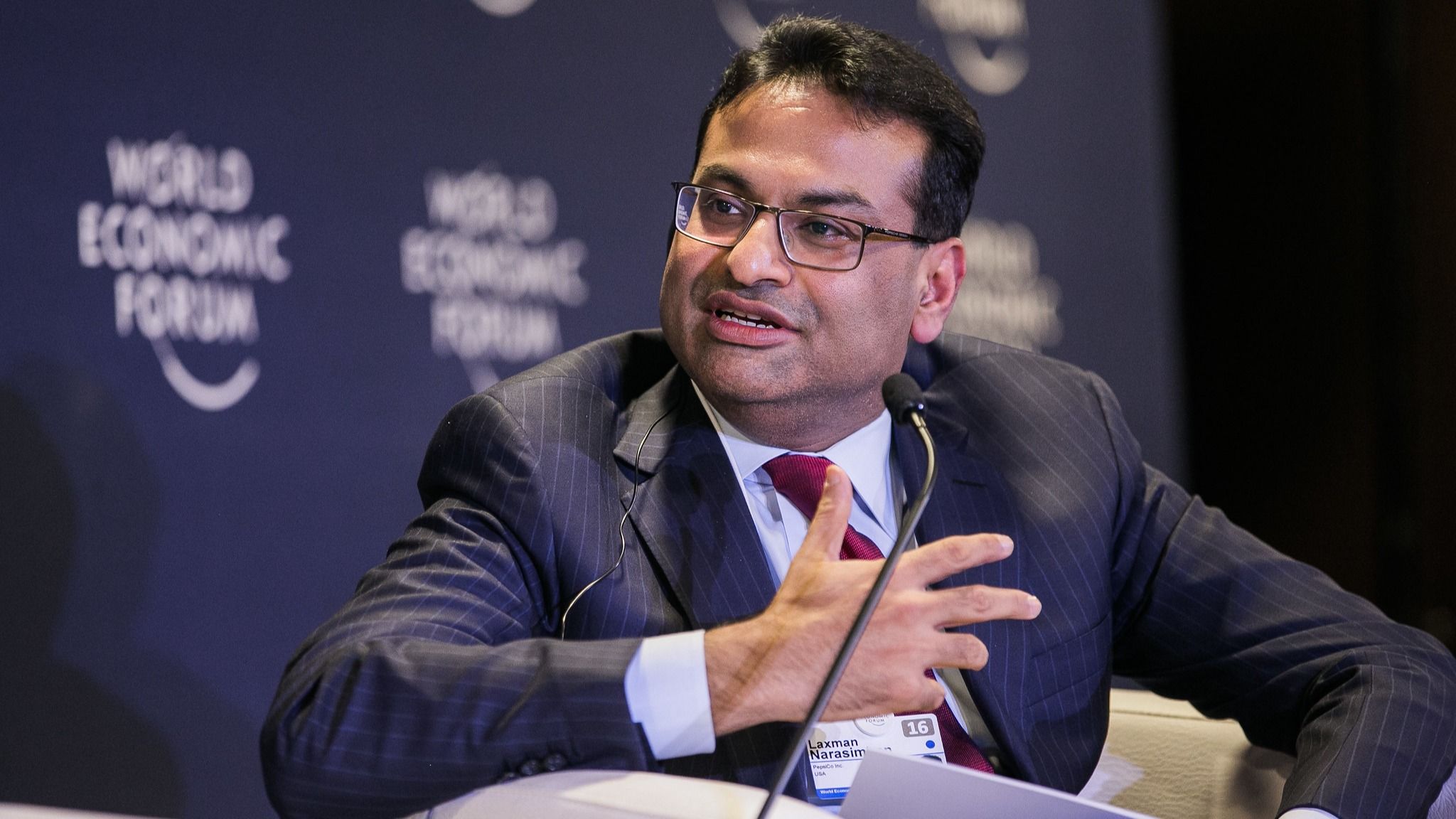Laxman Narasimhan’s Background and Career Path

Laxman Narasimhan, the current CEO of Starbucks, is a seasoned business leader with a distinguished career spanning over two decades. His journey, marked by strategic vision and a knack for driving growth, has positioned him as a key figure in the global consumer goods industry.
Narasimhan’s Education and Early Career, Starbucks ceo laxman narasimhan
Narasimhan’s path to leadership began with a strong academic foundation. He earned a Bachelor of Science degree in Mechanical Engineering from the University of Madras in India, followed by an MBA from the Wharton School of the University of Pennsylvania. This combination of technical and business acumen laid the groundwork for his future success. He started his career at McKinsey & Company, a global management consulting firm, where he honed his analytical skills and gained valuable experience in strategy development and execution.
Narasimhan’s Tenure at PepsiCo
Narasimhan’s career took a significant turn when he joined PepsiCo in 1999. He quickly rose through the ranks, demonstrating his ability to navigate complex business challenges and drive results. His key roles at PepsiCo, highlighted below, provide a glimpse into his leadership style and strategic thinking:
- Chief Financial Officer (CFO) of PepsiCo’s Quaker Foods North America: In this role, Narasimhan played a crucial role in streamlining operations and improving financial performance. He was instrumental in driving growth and profitability for the Quaker Foods division.
- Chief Executive Officer (CEO) of PepsiCo’s Latin America Beverages: Narasimhan’s leadership extended to international markets. He successfully led the company’s beverage operations in Latin America, expanding the market share and strengthening the brand’s presence.
- Chief Executive Officer (CEO) of PepsiCo’s Global Coffee Business: This role marked a turning point in Narasimhan’s career, bringing him into the coffee industry, a sector he would later lead at Starbucks. He spearheaded the development and implementation of strategies that significantly boosted PepsiCo’s coffee business, demonstrating his understanding of the market and consumer preferences.
Narasimhan’s Key Accomplishments at PepsiCo
Narasimhan’s contributions to PepsiCo’s success were significant. He spearheaded initiatives that led to:
- Increased Revenue and Market Share: Narasimhan’s leadership resulted in substantial revenue growth and increased market share for PepsiCo’s various divisions. He consistently delivered strong financial performance, a testament to his strategic acumen and ability to drive results.
- Enhanced Operational Efficiency: Narasimhan was known for his focus on operational excellence. He implemented strategies that streamlined processes, reduced costs, and improved efficiency across PepsiCo’s operations. This emphasis on efficiency played a crucial role in driving profitability.
- Strategic Acquisitions and Partnerships: Narasimhan actively pursued strategic acquisitions and partnerships to expand PepsiCo’s portfolio and reach new markets. His understanding of market dynamics and consumer trends guided these decisions, ensuring they aligned with PepsiCo’s long-term growth objectives.
“Laxman is a highly respected and proven leader with a deep understanding of the consumer goods industry. He has a track record of success in driving growth and profitability, and I am confident he will bring the same level of leadership to Starbucks.” – Indra Nooyi, former CEO of PepsiCo.
Starbucks Under Narasimhan’s Leadership

Laxman Narasimhan took the reins of Starbucks in April 2023, inheriting a company facing a confluence of challenges and opportunities. He stepped into a landscape marked by evolving consumer preferences, heightened competition, and the lingering effects of the pandemic. His arrival signaled a new era for Starbucks, one characterized by a renewed focus on operational excellence, customer experience, and growth.
Initial Strategic Priorities and Goals
Narasimhan’s initial strategic priorities reflected his commitment to addressing Starbucks’ immediate challenges and laying the foundation for long-term success. He Artikeld a multi-pronged approach, emphasizing:
- Reinvigorating the Starbucks Experience: Narasimhan recognized the need to rekindle the magic of the Starbucks experience. He vowed to elevate the customer journey, focusing on personalized service, elevated in-store ambiance, and enhanced digital offerings.
- Optimizing Operations and Efficiency: Recognizing the importance of streamlining operations, Narasimhan initiated efforts to improve operational efficiency. This included optimizing staffing levels, enhancing supply chain management, and refining store layouts to ensure a seamless customer experience.
- Driving Growth and Innovation: To sustain Starbucks’ growth trajectory, Narasimhan underscored the importance of innovation. He emphasized the need to introduce new products, explore new markets, and leverage technology to enhance customer engagement and drive sales.
Narasimhan’s Vision for Starbucks’ Future
Narasimhan’s vision for Starbucks’ future is rooted in a deep understanding of the evolving consumer landscape and the company’s core strengths. He envisions Starbucks as a global leader in the coffee industry, driven by:
- A Customer-Centric Approach: Narasimhan believes that Starbucks’ success hinges on understanding and meeting the evolving needs of its customers. He emphasizes the importance of personalized experiences, tailored offerings, and a seamless omnichannel experience.
- A Commitment to Sustainability: Narasimhan recognizes the growing importance of sustainability in consumer decision-making. He has Artikeld ambitious goals for Starbucks to become a more sustainable company, encompassing ethical sourcing practices, responsible waste management, and a commitment to environmental stewardship.
- A Culture of Innovation: Narasimhan views innovation as a key driver of growth. He is committed to fostering a culture of experimentation and creativity, encouraging employees to explore new ideas and bring innovative products and services to market.
Significant Changes and Initiatives Under Narasimhan’s Leadership
Narasimhan’s tenure has been marked by a series of significant changes and initiatives designed to achieve his strategic goals. These include:
- Re-imagining the Starbucks Store Experience: Narasimhan has initiated a comprehensive revamp of the Starbucks store experience. This includes redesigning store layouts, introducing new digital ordering and payment options, and enhancing the in-store ambiance to create a more welcoming and personalized experience for customers.
- Expanding Starbucks’ Global Footprint: Narasimhan is committed to expanding Starbucks’ global reach, targeting new markets and accelerating growth in existing regions. He is focusing on strategic partnerships, tailored product offerings, and localized marketing initiatives to ensure successful expansion.
- Investing in Technology and Innovation: Narasimhan recognizes the transformative power of technology. He has invested in new digital platforms, artificial intelligence, and data analytics to enhance customer engagement, optimize operations, and drive innovation.
Challenges and Opportunities for Starbucks: Starbucks Ceo Laxman Narasimhan

Starbucks, a global coffee giant, faces a dynamic and competitive market landscape. While it enjoys a loyal customer base and strong brand recognition, it also faces challenges in maintaining its market leadership and navigating evolving consumer preferences. However, these challenges also present opportunities for growth and innovation, which Laxman Narasimhan is poised to leverage.
Key Challenges Facing Starbucks
The current market landscape presents several challenges for Starbucks, including:
- Increased Competition: The coffee industry is highly competitive, with numerous established players and emerging brands vying for market share. This includes specialty coffee shops, fast-food chains offering coffee, and even grocery stores selling their own coffee brands. Starbucks needs to constantly innovate and differentiate its offerings to stay ahead of the competition.
- Shifting Consumer Preferences: Consumer preferences are evolving rapidly, with a growing emphasis on sustainability, ethical sourcing, and personalized experiences. Starbucks needs to adapt its products and operations to meet these evolving demands. For example, consumers are increasingly interested in plant-based options and sustainable coffee practices.
- Economic Uncertainty: The global economy is facing challenges, including inflation, supply chain disruptions, and geopolitical tensions. These factors can impact consumer spending and affect Starbucks’ profitability. The company needs to find ways to navigate these economic headwinds while maintaining its growth trajectory.
- Digital Transformation: The digital landscape is evolving rapidly, and Starbucks needs to keep pace with the latest trends in e-commerce, mobile ordering, and personalized marketing. The company needs to invest in its digital infrastructure and capabilities to enhance customer experience and drive growth.
Opportunities for Growth and Innovation
Despite the challenges, Starbucks has several opportunities for growth and innovation:
- Expanding Global Reach: Starbucks has a significant presence in the United States, but there is still room for growth in international markets. The company can leverage its brand recognition and operational expertise to expand into new regions and tap into emerging markets with a growing demand for coffee.
- Developing New Products and Services: Starbucks can continue to innovate by developing new products and services that cater to evolving consumer preferences. This includes exploring plant-based options, offering personalized experiences, and creating new beverage and food combinations.
- Leveraging Technology: Starbucks can leverage technology to enhance customer experience, improve operational efficiency, and drive growth. This includes investing in mobile ordering, personalized recommendations, and data analytics to better understand customer preferences and tailor offerings accordingly.
- Focus on Sustainability: Starbucks can further enhance its sustainability efforts by sourcing coffee ethically, reducing its environmental footprint, and supporting local communities. This aligns with growing consumer demand for ethical and sustainable brands.
Starbucks Performance Under Narasimhan’s Leadership
While it’s still early to assess Narasimhan’s full impact, initial signs suggest a focus on cost optimization, streamlining operations, and improving customer experience. He has introduced initiatives to enhance employee training, streamline ordering processes, and improve store efficiency. These efforts aim to improve profitability and drive customer satisfaction. It’s too early to say definitively how these initiatives will impact Starbucks’ performance in the long term, but they represent a shift towards a more focused and customer-centric approach.
Starbucks ceo laxman narasimhan – Laxman Narasimhan, the new CEO of Starbucks, inherits a legacy of both triumph and tribulation. The company, known for its iconic green logo and ubiquitous presence, has long been a titan in the coffee industry, but recent years have seen a shift in consumer tastes and a rise in competition.
Narasimhan’s leadership will be tested as he navigates the challenges of maintaining Starbucks’ position as a global leader, a task made even more difficult by the ever-changing landscape of the coffee market. He will have to carefully balance innovation and tradition, addressing the concerns of both loyal customers and the ever-growing cohort of coffee enthusiasts seeking new and exciting experiences.
ceo starbucks The weight of this responsibility rests heavily on his shoulders, and the future of Starbucks rests on his ability to navigate the complex currents of the coffee world.
Laxman Narasimhan, the new CEO of Starbucks, faces a daunting task. He must navigate a landscape where the once-ubiquitous coffee giant is grappling with rising costs, changing consumer preferences, and a growing sense of disillusionment. His challenge lies in reviving the company’s spirit, reconnecting with its loyal customers, and forging a new path in an ever-evolving market.
To understand the full weight of his mission, one need only look at the journey of his predecessor, Howard Schultz, who brought Starbucks to its zenith before stepping down. Now, with the eyes of the world upon him, Narasimhan must find a way to write the next chapter in the Starbucks story, a chapter that speaks of innovation, growth, and a return to the company’s core values.
This journey is detailed in starbucks ceo laxman narasimhan , a comprehensive article that explores the challenges and opportunities facing the new CEO.